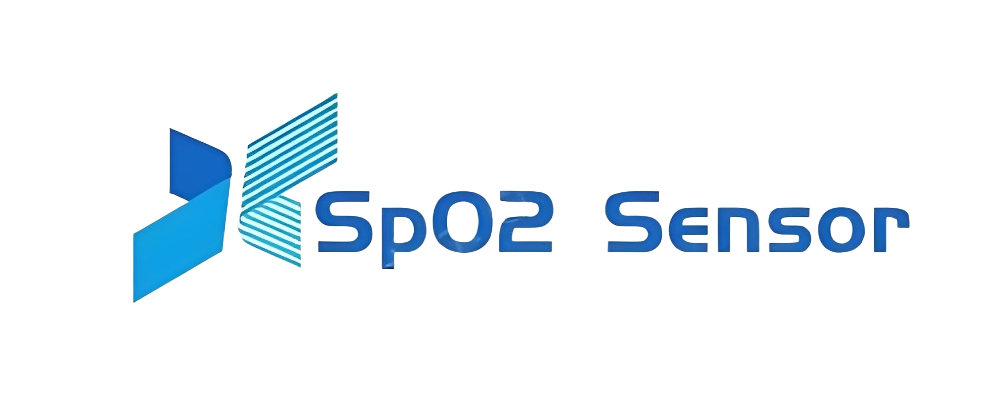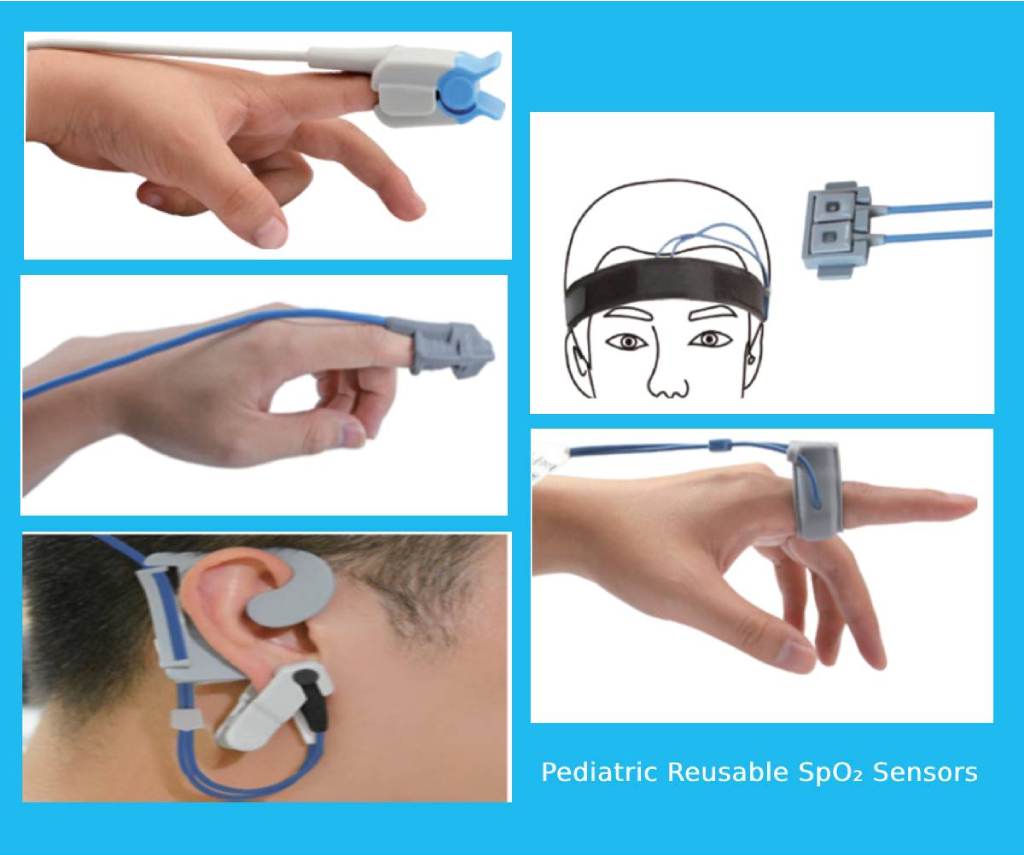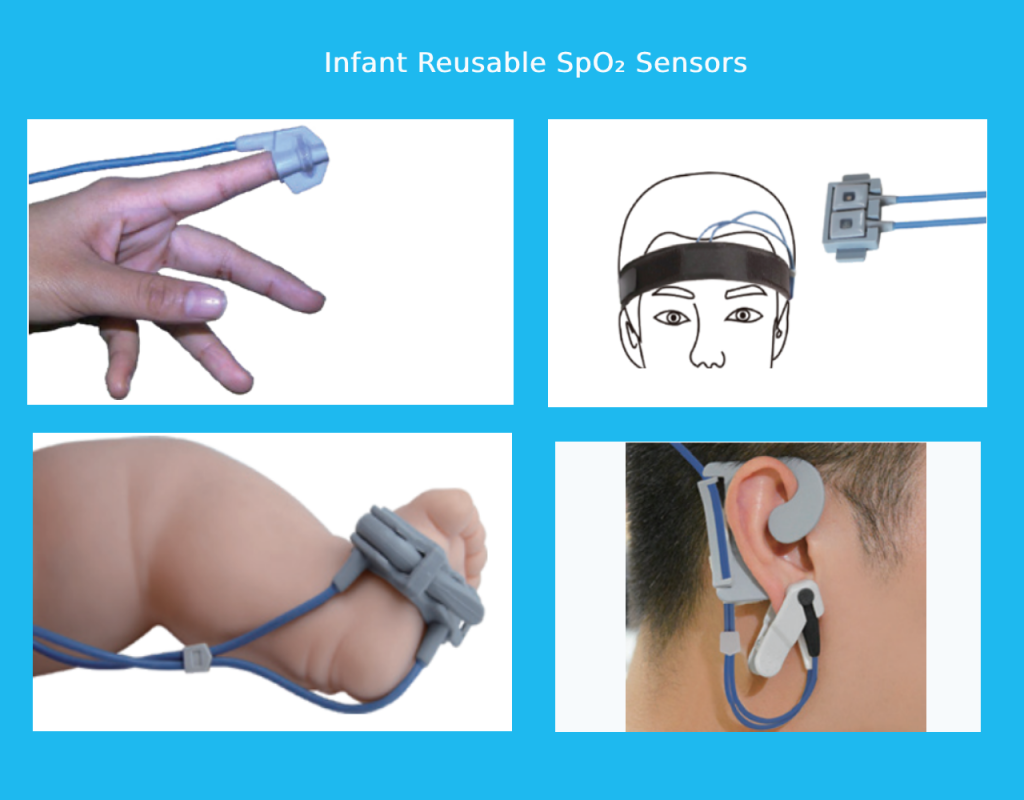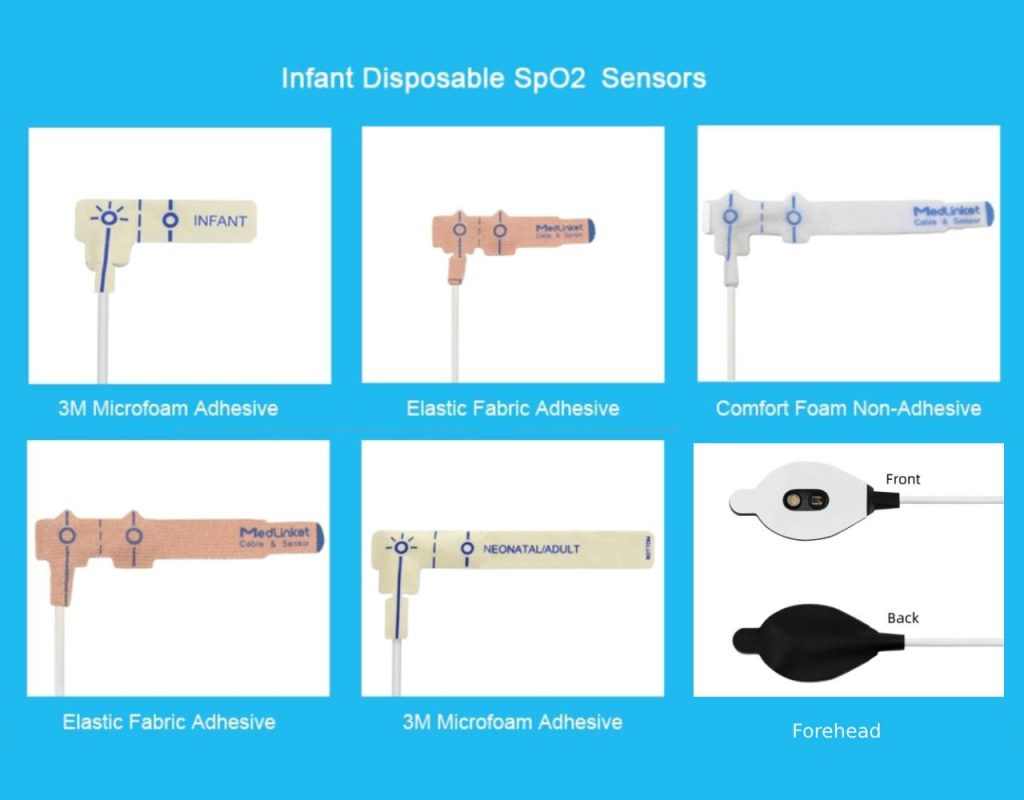Classification by Use Times
Reusable SpO2 sensors
- Application in ICU: In the ICU, patients are critically ill and require continuous, high-frequency monitoring of blood oxygen levels. Reusable SpO2 probes, known for their durability, can meet the demand for 24-hour continuous monitoring. These probes provide stable and continuous blood oxygen data, aiding medical staff in adjusting treatment plans promptly.
- Usage in Emergency Departments: In emergency departments, where patient conditions are urgent and rapidly changing, reusable probes can be quickly deployed to measure blood oxygen levels for various conditions. Their reusability helps control costs when dealing with a large influx of patients.
- Common Use in Outpatient Clinics: In outpatient settings, reusable SpO2 probes are used for routine check-ups and screening of underlying diseases. With a high patient turnover, these probes are easy to operate and can quickly measure blood oxygen levels for different patients, improving the efficiency of medical visits.
- Application in Home Care: For patients with chronic diseases or those who need long-term health monitoring at home, reusable SpO2 probes are cost-effective and easy to use. Patients can monitor their blood oxygen levels regularly and provide timely feedback to their doctors.

Disposable SpO2 sensors
- Demand in Anesthesiology: During anesthesia, precise monitoring of a patient’s vital signs is crucial. Disposable SpO2 probes eliminate the risk of cross-infection and provide reliable blood oxygen data throughout the induction, maintenance, and recovery phases of anesthesia, ensuring patient safety.
- Features in Operating Rooms: Operating rooms have strict hygiene requirements. Disposable probes are used for each surgery to prevent bacterial transmission between patients. Their design allows for quick installation and accurate measurement without disrupting the surgical process.
- Scenarios in ICU: In the ICU, disposable SpO2 probes are preferred when dealing with patients with special infections or when strict cross-infection control is necessary. They ensure patient safety while meeting the high demands of real-time blood oxygen monitoring.
Classification by Patient Size
SpO2 Probes for Adults


- Characteristics and Advantages: Adult SpO2 probes are larger in size, providing a broader contact area that better fits adult fingers, earlobes, and other measurement sites. They have strong signal acquisition capabilities, can accurately obtain blood oxygen data, and offer a certain level of interference resistance, making them suitable for blood oxygen monitoring during daily activities.
- Common Usage Scenarios: In hospital wards, adult patients use these probes to monitor blood oxygen levels during treatment, assisting medical staff in assessing their recovery progress. In health check-up centers, they are used for routine adult screenings to identify potential health issues.
SpO2 Probes for Pediatric
- Design Considerations: Children have delicate skin, so probes are designed with soft, gentle materials to avoid irritation. The probes are smaller in size to fit children’s fingers and toes precisely and ensure stable signal acquisition. Additionally, the appearance often includes cute elements to reduce children’s fear of medical devices.
- Application in Pediatric Care: In pediatric wards, these probes are used for routine monitoring of sick children to detect changes in their condition promptly. In pediatric outpatient clinics, they help doctors quickly measure blood oxygen levels during diagnosis.
SpO2 Probes for Infants
- Special Design Requirements: Infants have more fragile bodies, so probes must be made of ultra-soft materials to minimize pressure on their skin. The shape is designed to fit infants’ hands and feet well and has good fixity to prevent the probe from shifting during movement, which could affect monitoring results.
- Usage Precautions: When using these probes, it is essential to closely monitor the infant’s skin condition to prevent allergies or pressure injuries. The installation and removal process should be gentle to avoid accidental harm.
SpO2 Probes for Neonates

- Unique Design Requirements: Neonates have thin, sensitive skin, and their frequent limb movements require probes that can accurately collect data without causing discomfort. The probes must be designed to provide stable blood oxygen monitoring under various conditions.
- Importance in Newborn Care: Newborns have underdeveloped organs, and blood oxygen monitoring is a critical indicator of their health. Probes designed for newborns provide real-time, accurate blood oxygen data, helping medical staff detect potential health risks early and ensure the healthy growth of newborns.
Classification by Product Structure

Long-Cable (3m) Direct-Insertion (Integrated) SpO2 Probes
- Structural Features: These probes have a 3-meter-long cable, allowing for a longer distance between the patient and the monitoring device. The direct-insertion (integrated) design reduces the risk of signal loss from connector interfaces, with a compact internal structure that ensures stable signal transmission.
- Applicable Scenarios: These probes are suitable for situations where patients have a larger range of movement, such as in rehabilitation wards during physical therapy sessions. They also meet the needs of long-distance patient transport within hospitals, such as from wards to examination rooms.
- Advantages: The long-distance signal transmission is stable, reducing wear and tear on device connectors from frequent plugging and unplugging. The integrated structure is less prone to damage, resulting in lower maintenance costs.
Short-Cable (0.9m) SpO2 Probes

Reusable Short-Cable SpO2 Probes
- Necessity of Oximeter Extension Cables: Short-cable probes have limited connection distance, but extension cables can be used to adjust the length according to specific needs. This flexibility expands their usage range and meets the distance requirements between patients and monitoring devices in different scenarios.
- Usage Scenarios and Maintenance Tips: These probes are commonly used for close-range monitoring at the bedside in general wards. Maintenance involves regularly cleaning the probe surface and checking for cable damage to ensure proper functioning.
Disposable Short-Cable SpO2 Probes
Differences from Reusable Probes: Disposable probes are intended for single use, eliminating the risk of cross-infection and the need for complex cleaning and maintenance procedures. Their materials are designed for convenience in single-use applications, with a relatively lower cost per unit.
Application Scenarios and Advantages: These probes are suitable for operating rooms, ICUs, neonatal units, and other departments. Their advantage lies in their disposable nature, which saves time, reduces infection risks, and increases medical efficiency.
Classification by Probe Type
SpO2 Clip Probes
- Working Principle: These probes use light-emitting diodes to emit red and infrared light. The light passes through the finger skin and tissue and is received by a photodiode. Based on the differences in light absorption characteristics of blood at various oxygen saturation levels, the probe calculates the blood oxygen saturation.
- Application Scenarios and Advantages: Widely used in hospital wards and home care settings, clip-on probes are easy to operate. Patients simply place their finger in the clip to measure blood oxygen levels quickly.
Silicone Soft Tip SpO2 Sensors
- Design Features: These probes have a sleeve-like shape that completely covers the finger, increasing the contact area and improving signal acquisition accuracy. The soft material conforms to the finger’s shape, providing a comfortable fit.
- Applicable Populations and Scenarios: Suitable for individuals who require long-term blood oxygen monitoring, such as patients with sleep apnea during nighttime sleep. They are widely used in home sleep monitoring and remote medical applications.
Wrap-Around SpO2 Sensors
- Unique Design and Uses: These probes use a wrap-around band that can be secured around the patient’s wrist, ankle, or other limbs. The flexible design accommodates different limb sizes and ensures a secure fit that does not easily come off. They are used for patients who cannot cooperate with clip-on or finger-sleeve probes, such as infants and unconscious or agitated patients.
- Special Situations: In pediatric wards, wrap-around probes can continuously monitor blood oxygen levels in active infants. In emergency rooms, they can quickly secure and measure blood oxygen levels in comatose or agitated patients.
Ear-Clip SpO2 Sensors
- Measurement Principle and Features: These probes clip onto the earlobe, utilizing the rich vascular supply and good light transmittance of the earlobe. They emit and receive light signals to measure blood oxygen levels. The measurement site is relatively fixed, with minimal interference from external factors and without restricting hand movement.
- Medical Applications: Commonly used in operating rooms for anesthesia monitoring and long-term monitoring in ICUs. They are suitable for scenarios where patients need to keep their hands free for other treatments.
Y-Type Multisite SpO2 Sensors
Multi-Function Design: These probes have multiple interfaces that can connect to sensors on different body parts, such as fingers and earlobes. They can simultaneously monitor blood oxygen levels from multiple sites and provide a comprehensive analysis to improve monitoring accuracy. They are also compatible with various monitoring devices, offering strong versatility.
Wide Application Scenarios: Suitable for research institutions conducting complex physiological parameter monitoring and comprehensive intensive care units in large hospitals. They provide medical staff with more detailed and accurate patient blood oxygen information to assist in developing more scientific treatment plans.
Factors to Consider When Choosing an SpO2 Sensor
In addition to the type of blood oxygen technology, several other factors should be considered when selecting an SpO2 sensor:
Age
The age of the patient is crucial when selecting an SpO2 sensor, as the design of the sensor depends on the user. There are SpO2 sensors available for neonates, infants, children, and adults.
Weight
The weight of the patient also affects the choice of sensor. Therefore, it is important to check the weight specifications before selecting an SpO2 sensor to ensure that the user falls within the appropriate weight range.
Application Site
Knowing where the sensor will be placed is essential for obtaining accurate results. The design of SpO2 sensors varies depending on the application site, such as the foot, finger, wrist, toe, forehead, and ear. Incorrect placement can lead to inaccurate readings. Therefore, it is important to understand where the sensor will be used before making a selection.
Monitoring Duration
Each patient has different monitoring needs. Some require short-term monitoring, while others need continuous monitoring. If long-term monitoring is necessary, patient comfort should be considered.
Patient Activity Level
Movement can significantly affect the accuracy of SpO2 readings. Therefore, it is important to consider the patient’s activity level when selecting a sensor. Depending on the patient’s mobility, SpO2 sensors with low, limited, moderate, or high activity levels can be chosen.
Certification
Before purchasing a sensor, check whether it has been approved by regulatory bodies such as the FDA or CE. Certified SpO2 sensors meet quality standards and ensure accuracy. Additionally, certification indicates that the technology used has been validated by experts.




